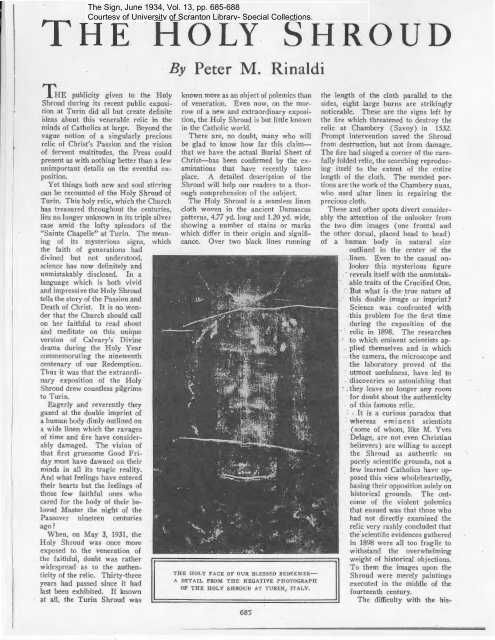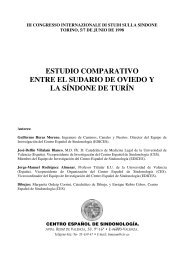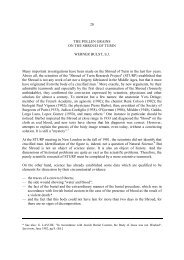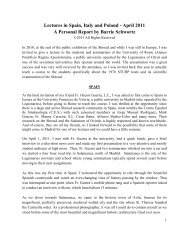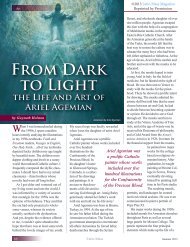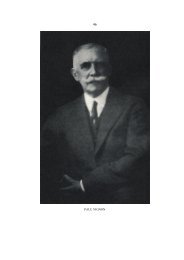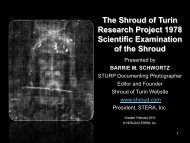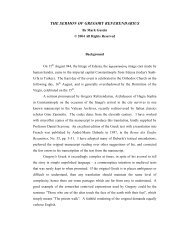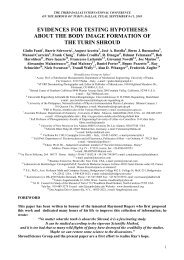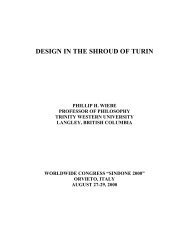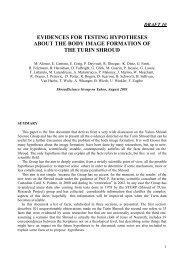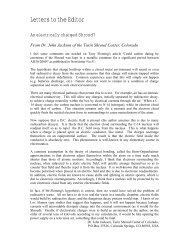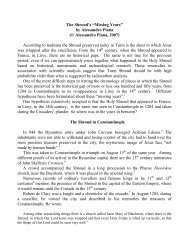the Holy Shroud - The Shroud of Turin Website
the Holy Shroud - The Shroud of Turin Website
the Holy Shroud - The Shroud of Turin Website
You also want an ePaper? Increase the reach of your titles
YUMPU automatically turns print PDFs into web optimized ePapers that Google loves.
THE HOLY SHROUDBy Peter M. RinaldiTHE publicity given to <strong>the</strong> <strong>Holy</strong><strong>Shroud</strong> during its recent public expositionat <strong>Turin</strong> did all but create definiteideas about this venerable relic in <strong>the</strong>minds <strong>of</strong> Catholics at large. Beyond <strong>the</strong>vague notion <strong>of</strong> a singularly preciousrelic <strong>of</strong> Christ's Passion and <strong>the</strong> vision<strong>of</strong> fervent multitudes, <strong>the</strong> Press couldpresent us with nothing better than a fewunimportant details on <strong>the</strong> eventful exposition.Yet things both new and soul stirringcan be recounted <strong>of</strong> <strong>the</strong> <strong>Holy</strong> <strong>Shroud</strong> <strong>of</strong><strong>Turin</strong>. This holy relic, which <strong>the</strong> Churchhas treasured throughout <strong>the</strong> centuries,lies no longer unknown in its triple silvercase amid <strong>the</strong> l<strong>of</strong>ty splendors <strong>of</strong> <strong>the</strong>"Sainte Chapelle" at <strong>Turin</strong>. <strong>The</strong> meaning<strong>of</strong> its mysterious signs, which<strong>the</strong> faith <strong>of</strong> generations haddivined but not understood,science has now definitely andunmistakably disclosed. In alanguage which is both vividand impressive <strong>the</strong> <strong>Holy</strong> <strong>Shroud</strong>tells <strong>the</strong> story <strong>of</strong> <strong>the</strong> Passion andDeath <strong>of</strong> Christ. It is no wonderthat <strong>the</strong> Church should callon her faithful to read aboutand meditate on this . uniqueversion <strong>of</strong> Calvary's Divinedrama during <strong>the</strong> <strong>Holy</strong> Yearcommemorating <strong>the</strong> nineteenthcentenary <strong>of</strong> our Redemption.Thtis it wa that <strong>the</strong> extraordinaryexposition <strong>of</strong> <strong>the</strong> <strong>Holy</strong> <strong>Shroud</strong> drew countless pilgrimsto <strong>Turin</strong>.Eagerly and reverently <strong>the</strong>ygazed at <strong>the</strong> double imprint <strong>of</strong>a human body dimly outlined ona wide linen which <strong>the</strong> ravages<strong>of</strong> time and fire have considerablydamaged. <strong>The</strong> vision <strong>of</strong>that first gruesome Good Fridaymust have dawned on <strong>the</strong>irminds in all its tragic reality.And what feelings have entered<strong>the</strong>ir hearts but <strong>the</strong> feelings <strong>of</strong>those few faithful ones whocared for <strong>the</strong> body <strong>of</strong> <strong>the</strong>ir belovedMaster <strong>the</strong> night <strong>of</strong> <strong>the</strong>Passover nineteen centuriesago?When, on May 3, 1931, <strong>the</strong><strong>Holy</strong> <strong>Shroud</strong> was once moreexposed to <strong>the</strong> veneration <strong>of</strong><strong>the</strong> faithful, doubt was ra<strong>the</strong>rwidespread as to <strong>the</strong> au<strong>the</strong>nticity<strong>of</strong> <strong>the</strong> relic. Thirty-threeyears had passed since it hadlast been exhibited. If knownat all, <strong>the</strong> <strong>Turin</strong> <strong>Shroud</strong> wasknown more as an object <strong>of</strong> polemics than<strong>of</strong> veneration. Even now, on <strong>the</strong> morrow<strong>of</strong> a new and extraordinary exposition,<strong>the</strong> <strong>Holy</strong> <strong>Shroud</strong> is but little knownin <strong>the</strong> Catholic world.<strong>The</strong>re are, no doubt, many who willbe glad to know how far this claimthatwe have <strong>the</strong> actual Burial Sheet <strong>of</strong>Christ-has been confirmed by <strong>the</strong> examinationsthat have recently takenplace. A detailed desct·iption <strong>of</strong> <strong>the</strong><strong>Shroud</strong> will help our readers to a thoroughcomprehension <strong>of</strong> <strong>the</strong> subject.<strong>The</strong> <strong>Holy</strong> <strong>Shroud</strong> is a seamless linencloth woven in <strong>the</strong> ancient Damascuspatterns, 4.77 yd. long and 1.20 yd. wide,showing a number <strong>of</strong> stains or markswhich differ in <strong>the</strong>ir origin and significance.Over two black lines runningTHE HOLY FACE OF OUR BLESSED REDEEMERA DETAIL FROM TilE NEGATIVE PHOTOGRAPHOF TilE HOLY SIIROUD AT TURIN, ITALY.685<strong>the</strong> length <strong>of</strong> <strong>the</strong> cloth parallel to <strong>the</strong>sides, eight large burns are strikinglynoticeable. <strong>The</strong>se are <strong>the</strong> signs left by<strong>the</strong> fire which threatened to destroy <strong>the</strong>relic at Chambery (Savoy) in 1532.Prompt intervention saved <strong>the</strong> <strong>Shroud</strong>from destruction, but not from damage.<strong>The</strong> fire had singed a corner <strong>of</strong> <strong>the</strong> carefullyfolded relic, <strong>the</strong> scorching reproducingitself to <strong>the</strong> extent <strong>of</strong> <strong>the</strong> entirelength <strong>of</strong> <strong>the</strong> cloth. <strong>The</strong> mended portionsare <strong>the</strong> work <strong>of</strong> <strong>the</strong> Chambery nuns,who used altar linen in repairing <strong>the</strong>precious cloth.<strong>The</strong>se and o<strong>the</strong>r spots divert considerably<strong>the</strong> attention <strong>of</strong> <strong>the</strong> onlooker from<strong>the</strong> two dim images (one frontal and<strong>the</strong> o<strong>the</strong>r dorsal, placed head to head)<strong>of</strong> a human body in natural sizeoutlined in <strong>the</strong> center <strong>of</strong> <strong>the</strong>-linen. Even to <strong>the</strong> casual onlookerthis mysterious figure- reveals itself with <strong>the</strong> unmistakabletraits <strong>of</strong> <strong>the</strong> Crucified One.- But what is -<strong>the</strong>-true nature <strong>of</strong>this double image or imprint?Science was confronted withthis problem for <strong>the</strong> f-irst timeduring <strong>the</strong> exposition <strong>of</strong> <strong>the</strong>rdic in 1898. <strong>The</strong> researchesto which eminent scientists applied<strong>the</strong>mselves and in which-- <strong>the</strong> camera, <strong>the</strong> microscope and<strong>the</strong> laboratory proved <strong>of</strong> <strong>the</strong>- utmost usefulness, have led todiscoveries so astonishing that; . <strong>the</strong>y leave no longer any roomfor doubt about <strong>the</strong> au<strong>the</strong>nticity<strong>of</strong> this famous relic.It is a curious -paradox thatwhereas eminent scientists(some <strong>of</strong> whom, like M. YvesDelage, are not even Christianbelievers) are willing to accept<strong>the</strong> <strong>Shroud</strong> as au<strong>the</strong>ntic onpurely scientific grounds, not afew learned Catholics have opposedthis view wholeheartedly,basing <strong>the</strong>ir opposition solely onhistorical gwunds. <strong>The</strong> outcome<strong>of</strong> <strong>the</strong> violent polemicsthat ensued was that those whohad not directly examined <strong>the</strong>relic very rashly concluded that<strong>the</strong>-scientific evidences ga<strong>the</strong>redin 1898 were all too fragile towithstand <strong>the</strong> overwhelmingweight <strong>of</strong> historical objections.To <strong>the</strong>m <strong>the</strong> images upon <strong>the</strong><strong>Shroud</strong> were merely paintingsexecuted in <strong>the</strong> middle <strong>of</strong> <strong>the</strong>fourteenth century.<strong>The</strong> difficulty with <strong>the</strong> his-
6$6torian <strong>of</strong> <strong>the</strong> <strong>Shroud</strong> is apparently veryserious. His efforts to reconstruct <strong>the</strong>chain <strong>of</strong> events that links <strong>the</strong> <strong>Turin</strong><strong>Shroud</strong> with Christ's burial have literallycome to nothing. <strong>The</strong> chronologicaldata at his service are all too scarce and<strong>of</strong>ten even doubtful. <strong>The</strong> few documentsthat directly bear on <strong>the</strong> subject wouldseem to discourage any serious attemptto prove <strong>the</strong> <strong>Shroud</strong>'s au<strong>the</strong>nticity onmerely historical grounds. Besides, itmust be stated, o<strong>the</strong>r "shrouds" areknown. to have existed.THESE objections, which <strong>the</strong> opponents<strong>of</strong> <strong>the</strong> au<strong>the</strong>nticity advancedwith so much certainty, face to face with<strong>the</strong> more recent examinations <strong>of</strong> <strong>the</strong> relic,have broken down irrevocably. In archeologywhen an object can supply itsown au<strong>the</strong>ntication it is <strong>of</strong> small consequencewhat may have been its history.Now <strong>the</strong> evidences ga<strong>the</strong>red from <strong>the</strong>objective examination <strong>of</strong> <strong>the</strong> <strong>Turin</strong><strong>Shroud</strong> are more than sufficient to warrantits claim to au<strong>the</strong>nticity. This explainswhy opposing scarce and doubtfulliterary documents to scientific evidences<strong>of</strong> <strong>the</strong> highest import has become, in <strong>the</strong>case <strong>of</strong> <strong>the</strong> <strong>Holy</strong> <strong>Shroud</strong>, a ra<strong>the</strong>r discomfortingtask.Doctor Arthur S. Barnes who, to anextensive knowledge <strong>of</strong> <strong>the</strong> <strong>Shroud</strong>'sliterature, joins <strong>the</strong> experience <strong>of</strong> apersonal examination <strong>of</strong> <strong>the</strong> Relic, thussums up <strong>the</strong> scientific evidences ga<strong>the</strong>redin 1898 and fully confirmed during <strong>the</strong>more recent expositions:"<strong>The</strong>re are four reasons, each <strong>of</strong>·whichcould be decisive by itself, and which,taken toge<strong>the</strong>r, make any fur<strong>the</strong>r suggestion<strong>of</strong> painting quite inadmissible. <strong>The</strong>y·are as follows:"I. <strong>The</strong> process <strong>of</strong> painting on a fabricinvolves <strong>the</strong> deposit <strong>of</strong> solid particles <strong>of</strong>coloring matter upon <strong>the</strong> threads, so that<strong>the</strong>se latter become partially or entirelyhidden. But in <strong>the</strong> case <strong>of</strong> <strong>the</strong> <strong>Shroud</strong>every thread is visible, and no trace <strong>of</strong>solid extraneous matter can be detectedeven by microscopic examination. <strong>The</strong>threads <strong>the</strong>mselves are stained more orless throughout, so that <strong>the</strong> same figures,fainter in coloring but o<strong>the</strong>rwise identical,appear on <strong>the</strong> o<strong>the</strong>r side. Not thuswas any human painting done in <strong>the</strong>fourteenth century, or indeed at anyo<strong>the</strong>r time."2. Human work, however minute,necessarily shows outline and shading.It may be so fine as completely to delude<strong>the</strong> unaided eye, but its nature at oncebecomes manifest when it is put under<strong>the</strong> microscope. But <strong>the</strong>se figures haveno outline and no trace <strong>of</strong> shading. <strong>The</strong>coloring becomes more or less intense byquite imperceptible degrees. <strong>The</strong> edgesfade away into <strong>the</strong> general fabric so thatit is impossible to say where <strong>the</strong> tint beginsand. where it ends. That effect ischaracteristic <strong>of</strong> natural processes; it isquite unattainable by human effort, atTHE t SIGNTHE HOLY SHROUD AS SEENBY THOUSANDS DURING ITSRECENT EXPOSITION AT TURIN.THE FIGURE OUTLINED ON THECLOTH RESEMBLES A PHOTO-GRAPHIC NEGATIVE,Vol. 1 3. No. 11any rate if unaided by any elaboratemechanical device."3. In <strong>the</strong> fourteenth century in Franceanatomy was not understood, and nothingwas known <strong>of</strong> <strong>the</strong> circulation <strong>of</strong> <strong>the</strong>blood. But here <strong>the</strong> anatomical detailand proportion is exact, <strong>the</strong> behavior <strong>of</strong>blood flowing from a wound is true tonature, and <strong>the</strong> contrast between livingblood and dead blood is duly preserved.Even <strong>the</strong> characteristic way in which aclot <strong>of</strong> blood dries, <strong>the</strong> coloring matterthicker on <strong>the</strong> circumference than in<strong>the</strong> center, is truly represented on <strong>the</strong><strong>Shroud</strong>, though it takes <strong>the</strong> microscopeto reveal it. But <strong>the</strong> realism <strong>of</strong> <strong>the</strong>fourteenth century was not <strong>of</strong> this kind;science had not attained to such details<strong>of</strong> knowledge, nor did men do work thatonly <strong>the</strong> microscope could test; <strong>the</strong>microscope itself had not been invented!"4. <strong>The</strong> fourth reasoi1 carries convictionto <strong>the</strong> mind even more readily thanthose three already g iven. It is that <strong>the</strong>figures upon <strong>the</strong> <strong>Shroud</strong> are shown reversedin light and shade, somethingafter <strong>the</strong> manner <strong>of</strong> a photographed negative.If <strong>the</strong>y are photographed <strong>the</strong>y produceupon <strong>the</strong> plate a positive picture,with light and shade more as we 1reaccustomed to see it. Even <strong>the</strong> expressionupon <strong>the</strong> face is perfect. But no humanbeing, even now, could paint in this way,not even if. he were an expert retoucher<strong>of</strong> photographs. Such a one might beable to produce a passable representation<strong>of</strong> a human body in negative, butto preserveso delicate a thing as <strong>the</strong> expressionon a face while thus reversing <strong>the</strong> lightand shade is quite beyond human skill. Ifthat is so even today, when photographyhas made us familiar with <strong>the</strong> phenomena<strong>of</strong> inverted light and shade, how muchwas it so in <strong>the</strong> fourteenth century, when<strong>the</strong> very idea had not yet been thought <strong>of</strong>.Nor, even if it had been possible, could<strong>the</strong>re be any conceivable motive whichwould have led a painter to work in thisway, and make his wod< so hard tounderstand."<strong>The</strong>se four considerations are sufficientto put completely out <strong>of</strong> court <strong>the</strong><strong>the</strong>ory that <strong>the</strong> <strong>Shroud</strong> is nothing but' ·amedieval painting. It should never beheard <strong>of</strong> again."THE double imprint upon <strong>the</strong> <strong>Shroud</strong>has, <strong>the</strong>n, all <strong>the</strong> characteristics <strong>of</strong> aphotographic negative (light and shadereversed, inverted positions, etc.) so thatif photographed it produces on <strong>the</strong> plate<strong>the</strong> positive picture <strong>of</strong> a man exact inevery detail, proportioned, artisticallybeautiful and endowed with a marvelousexpression. Through photography wehave <strong>the</strong> surest identification <strong>of</strong> thismysterious image and <strong>the</strong> ir'tefutablepro<strong>of</strong> <strong>of</strong> <strong>the</strong> <strong>Shroud</strong>'s au<strong>the</strong>nticity.<strong>The</strong> magnificent photographs, takenin 1931 by competent Signor Enrie <strong>of</strong><strong>Turin</strong> and issued with ecclesiasticalauthority, have once more disclosed <strong>the</strong>
June, 1934astonishing characters <strong>of</strong> <strong>the</strong> figures <strong>of</strong><strong>the</strong> <strong>Shroud</strong>.<strong>The</strong> stain images <strong>of</strong> <strong>the</strong> linen becomeon <strong>the</strong> photographic negative (plate) aperfect portrait <strong>of</strong> a dead body, andevidently enough <strong>of</strong> <strong>the</strong> body <strong>of</strong> a manwho has suffered crucifixion after a cruelscourging; who has been crowned withthorns and whose side has been piercedwith a lance. <strong>The</strong> face which on <strong>the</strong><strong>Shroud</strong> is quite meaningless, reversed asit is in light and shade, takes on <strong>the</strong>photographic negative <strong>the</strong> wondrousexpression which has excited <strong>the</strong> admiration<strong>of</strong> countless artists. <strong>The</strong> woundwhich is to be seen in <strong>the</strong> left wrist (<strong>the</strong>right hand is covered ove1· by <strong>the</strong> left),while against all pictorial traditions, isin perfect harmony with anatomicalrequisites. <strong>The</strong> rivulets <strong>of</strong> blood visibleon both forearms would imply that <strong>the</strong>arms <strong>of</strong> <strong>the</strong> Crucified One were raisedabove <strong>the</strong> head. <strong>The</strong> arms had, <strong>the</strong>refore,to support much <strong>of</strong> <strong>the</strong> weight <strong>of</strong> <strong>the</strong>body. <strong>The</strong> long nail, driven through <strong>the</strong>lower part <strong>of</strong> <strong>the</strong> palm, would have to beslanted downwards that it might hold<strong>the</strong> better and not tear through <strong>the</strong> flesh.<strong>The</strong> wound on <strong>the</strong> back <strong>of</strong> <strong>the</strong> hand wouldnaturally come out on <strong>the</strong> wrist.THE wounds <strong>of</strong> <strong>the</strong> feet are strikinglynoticeable on <strong>the</strong> back image,part <strong>of</strong> <strong>the</strong> linen having been foldedback from <strong>the</strong> heels so that it lay along<strong>the</strong> bloodstained soles.<strong>The</strong> wound <strong>of</strong> <strong>the</strong> side is clearlysituated on <strong>the</strong> right (in proximity <strong>of</strong> <strong>the</strong>mended portion <strong>of</strong> <strong>the</strong> I in en). <strong>The</strong> flowing<strong>of</strong> <strong>the</strong> blood is true to nature. DoctorP. Barbet <strong>of</strong> Paris can infer <strong>the</strong> trail <strong>of</strong><strong>the</strong> lance from <strong>the</strong> position <strong>of</strong> <strong>the</strong> wound."It penetrated between <strong>the</strong> fifth and sixthrib, bored through <strong>the</strong> right lung andpierced <strong>the</strong> right auricle <strong>of</strong> <strong>the</strong> heart."<strong>The</strong> scourge has left traces <strong>of</strong> its gruesomework over <strong>the</strong> entire body; yet <strong>the</strong>bruises are particularly numerous anddistinct on <strong>the</strong> dorsal region. <strong>The</strong>irshape, number (about 80) and distribution(two by two) enable us to infe1· that<strong>the</strong> condemned was inflicted <strong>the</strong> fortylegal st1'okes and that <strong>the</strong> two whip lasheswere provided with a metal strip. But<strong>the</strong> eye is irresistibly drawn to <strong>the</strong> face<strong>of</strong> this mysterious figure. It is a truephotographic portrait because it has resultedfrom a negative (<strong>the</strong> stained image<strong>of</strong> <strong>the</strong> <strong>Shroud</strong>) . <strong>The</strong> features are asimpressive as <strong>the</strong>y are definite : <strong>the</strong> whiteshowing blood marks on <strong>the</strong> foreheadtell <strong>of</strong> <strong>the</strong> crown <strong>of</strong> thorns; <strong>the</strong> longsemitic nose shows a pronounced tumefaction; <strong>the</strong> right cheek is swollen; <strong>the</strong>lower lip slightly protruding; <strong>the</strong> hairstiffened by <strong>the</strong> sweat and <strong>the</strong> tricklingblood.Yet nei<strong>the</strong>r <strong>the</strong> insults <strong>of</strong> <strong>the</strong> mob no1·<strong>the</strong> agony <strong>of</strong> an excruciating death hasaltered <strong>the</strong> calm, serene, majestic expression·<strong>of</strong> this incomparable countenance.One can ·only cry out with Pr<strong>of</strong>essorTHE t SIGNTHE HOLY SHROUD AS IT APPEARS ON THE PHOTOGRAPHICNEGATIVE PLATE. THE FIGUREIS NO LONGER NEGATIVE, BUTHAS TURNED POSITIVE. NOTETHE DISTINCT BODY.687Yves Delage, non-Catholic and nonChristian as he was, "Who but <strong>the</strong>Christ could impress this image on <strong>the</strong><strong>Shroud</strong>?"Some <strong>the</strong>re are, even among <strong>the</strong> morelearned admi1·ers <strong>of</strong> <strong>the</strong> <strong>Holy</strong> <strong>Shroud</strong>,who would not entirely eliminate <strong>the</strong>supernatural factor in dealing with thisrelic. <strong>The</strong>y see something more than <strong>the</strong>merely ordinary course <strong>of</strong> nature in <strong>the</strong>way with which God was pleased to leaveto His Church so striking a memorial <strong>of</strong><strong>the</strong> Passion <strong>of</strong> His Son. <strong>The</strong> scientist,however, believes himself to have reacheda very definite conclusion as to <strong>the</strong> origin<strong>of</strong> <strong>the</strong> <strong>Shroud</strong>'s images. Whatever providentialguiding <strong>the</strong>re may have been,<strong>the</strong>ir origin, he holds, was natural.CLEARLY, <strong>the</strong>se images are not <strong>the</strong>work <strong>of</strong> an artist; consequently<strong>the</strong>y can only have been caused by someinfluence proceeding from an actual bodywhich was laid upon one half <strong>of</strong> <strong>the</strong> sheetand <strong>the</strong>n covered with <strong>the</strong> remaining portion.But under what circumstances cana dead body produce upon <strong>the</strong> linen whichsurrounds it definite images <strong>of</strong> itself suchas we see upon <strong>the</strong> <strong>Shroud</strong>? Two are<strong>the</strong> requisites determined by laboratoryexperiments: first, a coloring substance. on <strong>the</strong> linen, which being thus madesusceptible <strong>of</strong> impression, would actmuch like <strong>the</strong> sensitized plate in <strong>the</strong>camera; second, a fluid emanated from<strong>the</strong> body which determining a reactionwith <strong>the</strong> coloring substances causes indeliblestains to be formed on <strong>the</strong> linen.This fluid is evidently a gas since it actsat a distance and by osmosis throughwhatever linen cloths that might separate<strong>the</strong> sheet from direct contad with<strong>the</strong> skin. Fur<strong>the</strong>rmore it must draw itsorigin from <strong>the</strong> blood. <strong>The</strong> stain images<strong>of</strong> <strong>the</strong> <strong>Shroud</strong> show that <strong>the</strong> emanationhas been present in greater activit'ywhere <strong>the</strong> flesh was bruised and most <strong>of</strong>all in <strong>the</strong> blood itself.Now physiology points to urea, preser.tboth in <strong>the</strong> clotted blood and in <strong>the</strong>sweat, as a substance which yield s firstcarbonated ammonia and <strong>the</strong>n ammoniacalgases. Experiments have shown thatalkaline substances, such as ammonia,react with a principle <strong>of</strong> <strong>the</strong> aloe; forminga reel-brown colored and coloringsubstance.It was following <strong>the</strong>se considerationsand <strong>the</strong> Gospel narratives that PaulVignon, Pr<strong>of</strong>essor <strong>of</strong> Biology in <strong>the</strong>Institut Catholique <strong>of</strong> Paris, framed hisfamous <strong>the</strong>ory <strong>of</strong> "contact" experimentedand accepted as <strong>the</strong> most probable explanation<strong>of</strong> <strong>the</strong> <strong>Shroud</strong>'s images byeminent pr<strong>of</strong>essors <strong>of</strong> <strong>the</strong> SorbonneUniversity.<strong>The</strong> body <strong>of</strong> <strong>the</strong> Redeemer was givena hurried and temporary burial. We insiston this fact because, while it answersto truth, it is <strong>of</strong> capital importance to <strong>the</strong><strong>the</strong>ory."<strong>The</strong> sabbath drew on" (Luke 23, 54)
688and <strong>the</strong> usual ceremonies had to be postponedto <strong>the</strong> first clay after <strong>the</strong> hallowedseason <strong>of</strong> rest. <strong>The</strong> fact that <strong>the</strong> women"returning prepared spices and ointments"(Lnke 23, 56) implies that <strong>the</strong>body had not been anointed at all. St.John says that "<strong>the</strong>y bound it in linencloths with spices, as <strong>the</strong> manner <strong>of</strong> <strong>the</strong>Jews is to bury." (! ohn 19, 40.) He doesnot say that <strong>the</strong>y went through all <strong>the</strong>operations after <strong>the</strong> manner <strong>of</strong> <strong>the</strong> Jews.It is ra<strong>the</strong>r arbitrary, <strong>the</strong>n, to infer fromthat text that <strong>the</strong> body was washed,anointed and wrapt with <strong>the</strong> long linenbands. What would <strong>the</strong> women come to<strong>the</strong> tomb for early on Sunday morning?Still unprepared for <strong>the</strong> definite burial,<strong>the</strong> Body <strong>of</strong> <strong>the</strong> Savior was laid uponone half <strong>of</strong> a "clean linen cloth" and <strong>the</strong>ncovered with <strong>the</strong> o<strong>the</strong>r half. This linen,purchased by Joseph <strong>of</strong> Arima<strong>the</strong>a on<strong>the</strong> spur <strong>of</strong> <strong>the</strong> moment (Marll 15, 46),had been pr<strong>of</strong>usely spread with <strong>the</strong> spices(a compound <strong>of</strong> myrrh and aloes groundand mixed toge<strong>the</strong>r) provided by Nicodemus(John 19, 39). It is quite certainthat some smaller linens were used besides<strong>the</strong> wide sheet. <strong>The</strong> hands, reverentlycomposed toge<strong>the</strong>r, were boundwith a strip <strong>of</strong> cloth. <strong>The</strong> napkin referredto by St. John (! ohn 20, 7) wasprobably put about <strong>the</strong> head to hold <strong>the</strong>chin into position. A cloth was quitecertainly placed about <strong>the</strong> loins where<strong>the</strong> hands rested.Joseph, after having thus "wrapped<strong>the</strong> body in <strong>the</strong> clean linen cloth laid itin his own new monument" (Matt. 27,THE t SIGN60) ; "<strong>the</strong>re," adds St. John, "because <strong>of</strong><strong>the</strong> parasceve <strong>of</strong> <strong>the</strong> Jews, because <strong>the</strong>sepulchre was nigh at hand." It was,<strong>the</strong>n, but a temporary deposition <strong>the</strong>yprovided for <strong>the</strong> body <strong>of</strong> <strong>the</strong>ir belovedMaster, and this in view <strong>of</strong> <strong>the</strong> definiteburial <strong>the</strong>y would give It soon after <strong>the</strong>hallowed repose <strong>of</strong> <strong>the</strong> Great PaschalSabbath.THE Body which <strong>the</strong> <strong>Shroud</strong> envelopedwas exceptionally fit to produce<strong>the</strong> amount <strong>of</strong> ammonia necessary for <strong>the</strong>reaction. An agony <strong>of</strong> sorrow and <strong>of</strong> dismayhad drawn from its pores a heavyperspiration <strong>of</strong> blood, particles <strong>of</strong> whichremained hidden along <strong>the</strong> channels <strong>of</strong><strong>the</strong> sweat glands. <strong>The</strong>n, <strong>the</strong> scourging,<strong>the</strong> crowning with thorns, <strong>the</strong> tragicjourney up Calvary, <strong>the</strong> crucifixion, <strong>the</strong>violent death after hours <strong>of</strong> untold sufferings.<strong>The</strong>se were <strong>the</strong> determiningcauses <strong>of</strong> an abundant emanation <strong>of</strong> ammoniacalgases which, developing from<strong>the</strong> dissolving urea, reacted with <strong>the</strong>aloe on <strong>the</strong> <strong>Shroud</strong>.<strong>The</strong> ammoniacal vapors did not equallyreact on <strong>the</strong> different parts <strong>of</strong> <strong>the</strong> sheet.<strong>The</strong> linen was stained through andthrough; very strongly at those pointswhere <strong>the</strong>re had been actual contact, lessintensely precisely in porportion to <strong>the</strong>distance which separated that particularportion <strong>of</strong> <strong>the</strong> Body from <strong>the</strong> surface <strong>of</strong><strong>the</strong> sheet. <strong>The</strong> blood and <strong>the</strong> bruises actedmost strongly <strong>of</strong> all, and made darkerand redder stains. <strong>The</strong> images thusformed present <strong>the</strong> appearance <strong>of</strong> aVol. 1 3. No. 11photographic negative, with light andshade reversed from <strong>the</strong> effect ordinarilyproduced upon our eyes.As to <strong>the</strong> probability <strong>of</strong> this <strong>the</strong>ory,which still enjoys <strong>the</strong> favor <strong>of</strong> manylearned admirers <strong>of</strong> <strong>the</strong> <strong>Turin</strong> Relic, wewill observe with Doctor Barnes that toreproduce <strong>the</strong> conditions <strong>of</strong> <strong>the</strong> crucifixionis obviously impossible. Once it isgranted that <strong>the</strong> images like those on <strong>the</strong><strong>Shroud</strong> may conceivably have beencaused by slow chemical action <strong>of</strong> thiskind, <strong>the</strong>re is little to be gained by fur<strong>the</strong>rexperiment. But it will be well to notethat all <strong>the</strong> four points, mentioned beforein order to prove that in <strong>the</strong> case <strong>of</strong> <strong>the</strong><strong>Shroud</strong> we are not dealing with anyhuman production, are precisely thosewhich would certainly be present in anysuch work <strong>of</strong> nature.Does <strong>the</strong> <strong>the</strong>ory <strong>of</strong> contact exclude <strong>the</strong>supernatural factor?When we think <strong>of</strong> <strong>the</strong> unusual processthat has caused <strong>the</strong> images on <strong>the</strong> <strong>Shroud</strong>and consider all <strong>the</strong> circumstances thatwere necessary for <strong>the</strong>ir production, wecannot but admire <strong>the</strong> Providence <strong>of</strong> GodWho was pleased to leave to <strong>the</strong> Churchand to <strong>the</strong> world <strong>the</strong> material document<strong>of</strong> <strong>the</strong> Passion and Death <strong>of</strong> Christ. Andif by a new and no less admirable trait <strong>of</strong>His Providence, it has pleased Him toreveal to us <strong>the</strong> figure <strong>of</strong> <strong>the</strong> sufferingGod-Man, it is doubtlessly in order tocall us to a greater and deeper appreciation<strong>of</strong> His love for us. "He hath lovedus, and hath delivered himself for us."(Eph. 5, 2.)UNCLE SAM: INVESTOR<strong>The</strong> Government Enters <strong>the</strong> Investment MarketBy Gerhard HirschfeldN GW that <strong>the</strong> wheels <strong>of</strong> industryare turning again, that more men go towork and larger pay envelopes find <strong>the</strong>irway into millions <strong>of</strong> happy homes, oldfriends are showing up again: doubts in<strong>the</strong> Government's wisdom, complaintsabout retarding what is convenientlyca1led <strong>the</strong> natural process <strong>of</strong> business recovery,and last, but by no means least,a ra<strong>the</strong>r tardy self-awakening <strong>of</strong> privatebusiness, proudly proclaiming its abilityto pull itself up by its own bootstraps.We have not heard much from privatebusiness since <strong>the</strong> spring <strong>of</strong> 1933 when itwas not precisely ambitious to get anywhere,except out <strong>of</strong> <strong>the</strong> red. Occasionally,it was accused <strong>of</strong> code violation;more <strong>of</strong>ten, it showed itself ready to cooperate,or, at least, careful not to takeany direct attitude toward, in favor oragainst, <strong>the</strong> New Deal, as long as <strong>the</strong>course <strong>of</strong> business was not more definitelyascertained.<strong>The</strong> time has come now when evenconservative business interests admit <strong>the</strong>general improvement that has takenplace in almost every field and branch.And, with <strong>the</strong> assurance <strong>of</strong> a limitedamount <strong>of</strong> business recovery, <strong>the</strong>re hascome an also limited amount <strong>of</strong> oppositionon <strong>the</strong> part <strong>of</strong> private business.<strong>The</strong>re is, as you can convince yourselfin your daily routine <strong>of</strong> news digesting,opposition to fur<strong>the</strong>r restriction <strong>of</strong> production,to fur<strong>the</strong>r reduction <strong>of</strong> workinghours, to code administration, and manyo<strong>the</strong>r prominent New Deal measures.One <strong>of</strong> <strong>the</strong> more important attacksdeals with <strong>the</strong> complaint that <strong>the</strong> Governmentis competing with privatecapital in seeking investment opportunities.<strong>The</strong> recovery program absorbsmany a million dollars which, in normalyears, would have gone directly to industry.By <strong>the</strong> middle <strong>of</strong> next year, it is estimated,<strong>the</strong> Government will have spentmore than ten billion dollars for purposeswhich, in former years, attractedprivate capital, for instance, loans tobanks, to farmers, to home owners, railroads,mortgage companies, power trusts,and <strong>the</strong> like. <strong>The</strong>re is truth in thischarge. <strong>The</strong> Government is, indeed, in-


